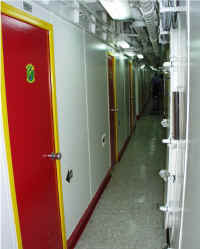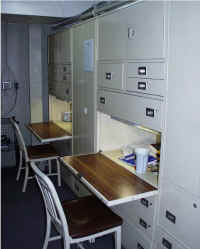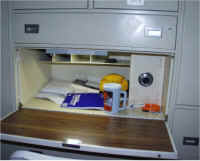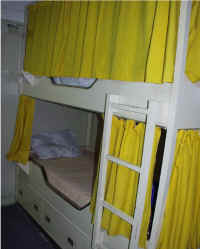



|
This passageway is typical of the living
spaces for the Chief Petty Officers and Officers of the ship. Behind each
door is a stateroom.
Stateroom capacity varies from 2 to 4, but the configurations are
similar.
Each person assigned to a stateroom has a desk and chair. The built-in
cabinets are for clothing, personal items, and reading/writing materials.
In addition, each desk has a safe for securing valuables and sometimes
classified material.
Each person also has a bed, either a top or bottom bunk. The bunks are
comfortable, with reading lights and privacy curtains.
Often, the staterooms contain a sink.
There are some rules for use of a stateroom:
- Always keep things picked up and neat. Failure to follow this rule
creates a health and safety hazard, as well as an annoyance for your
stateroom partner(s).
- If someone is asleep, try not to awaken them as you come and go.
With watchstanding responsibilities, you may often have somewhat
different working hours than your stateroom partner.
- Never bring any food into your stateroom. All food must remain in
the messing (eating) areas. Failure to follow this rule can easily
result in undesired mammals (rats) or arthropods (cockroaches, ants)
into your stateroom. You will have more food available to you at
meal-times than you can possibly eat. In addition, the mess decks and
wardroom usually have some snacks available. Never bring any food into
your stateroom.
- Make your own bed, every day, in the morning.
- If clothes need washing, wash them yourself or send them to the
ship's laundry. Don't let them hang in your closet.
Source:
Operational Medicine 2001, Health
Care in Military Settings, NAVMED P-5139, May 1, 2001, Bureau
of Medicine and Surgery, Department of the Navy, 2300 E Street NW, Washington,
D.C., 20372-5300
|





